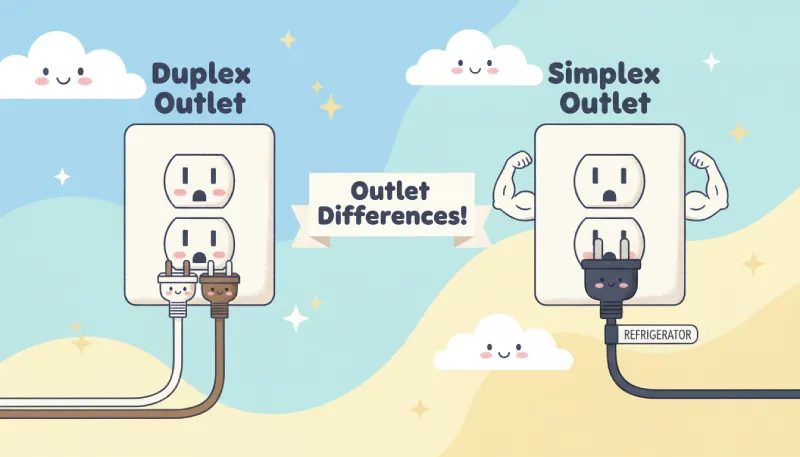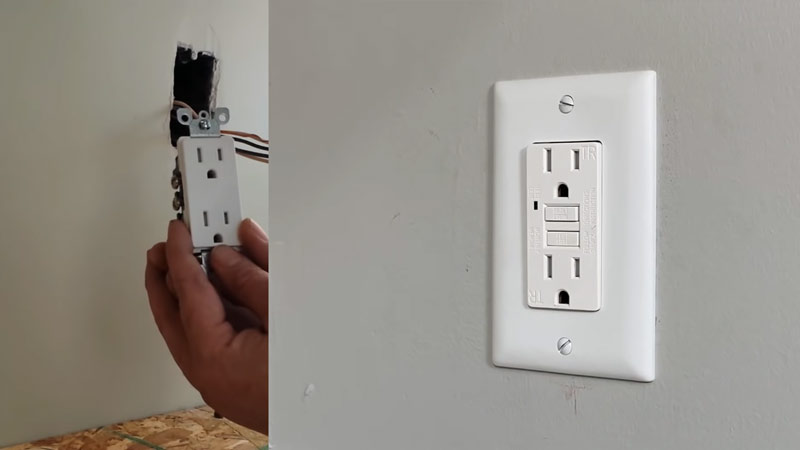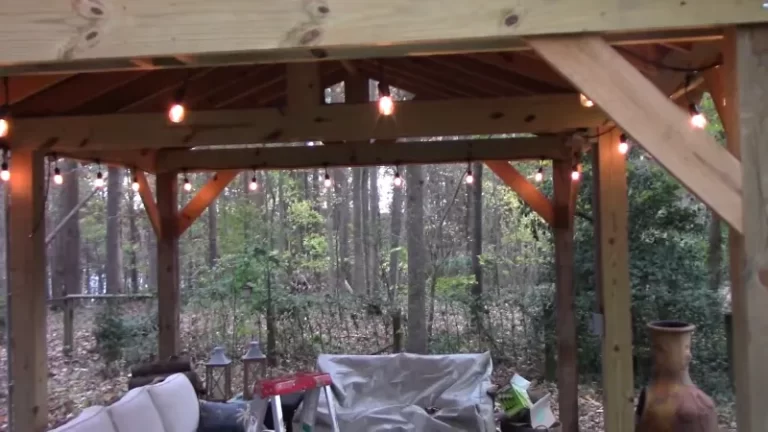What’s The Difference Between A Duplex Outlet And A Regular Outlet
If you’re using an outlet that is rated at a lower amperage, use the TR receptacle. If your appliance requires a higher amperage, use the WR receptacle.
Make sure to select the right type of receptacle for your needs before connecting your cords. Both receptacles have the same output so be sure to choose which one will fit your requirements best.
Be sure to double-check that you’re using the correct outlet by looking for its specific markings or model number before powering on your appliances.
You'll Learn About
What’s The Difference Between A Duplex Outlet And A Regular Outlet?
The term “duplex outlet” simply refers to the common electrical receptacle with two places to plug in devices. In North America, this is the “regular outlet” you see throughout your home. When you say “regular outlet,” you’re likely thinking of a duplex outlet, which is the standard in most homes. The key difference lies in the number of devices you can plug in. A duplex outlet has two receptacles, while a simplex outlet has only one.
The most obvious difference is the number of plug-in spots. A duplex outlet allows you to power two devices from a single outlet, making it a versatile choice for most rooms in a house.
A simplex outlet, on the other hand, is designed for a single, dedicated purpose. You’ll often find these used for large appliances that draw a significant amount of power, such as a refrigerator or a microwave. This is to ensure that the appliance has a dedicated circuit and isn’t competing for power with other devices, which could lead to tripped breakers.
In terms of wiring, both outlets connect to your home’s electrical system in a similar way, with connections for hot, neutral, and ground wires.

TR Receptacle
A duplex outlet allows for two electrical devices to be plugged in at the same time, whereas a regular outlet only accommodates one device.
This is the basic definition. A duplex outlet is the most common type of receptacle and is considered the regular, standard outlet in most homes. Single-receptacle outlets are far less common in residential settings.
The letters on an outlet, like “TR,” do not refer to its amperage rating. TR stands for Tamper-Resistant. A TR receptacle has internal shutters that prevent objects from being inserted into the slots, which is an important safety feature, especially for homes with children. This feature has nothing to do with whether the outlet is rated for high or low amps. High-power appliances like a dryer or an electric range require dedicated, high-amperage outlets (like 30-amps) that have a completely different shape and are not TR receptacles.
WR Receptacle
A WR receptacle is specifically designed to handle environmental conditions, not a specific amount of amps.
The letters WR stand for Weather-Resistant. These outlets are built with corrosion-resistant materials to protect them from moisture, humidity, and sun exposure. You’ll find these outlets in outdoor locations like decks and patios, or in damp places like garages. WR outlets can be rated for 15 amps or 20 amps, just like standard indoor outlets. They are not specifically for “lower power consumption” and should not be used in living rooms or bedrooms; those locations require TR (Tamper-Resistant) outlets.
Both Receptacles Have The Same Output
A duplex outlet is a two-outlet receptacle found in many homes. They have the same voltage output, making them electrically compatible with standard plugs.
A standard duplex outlet is not smaller than a single (“regular”) outlet; they both fit in the same standard electrical box. You do not need an adapter to use a standard appliance plug with a duplex outlet. Appliances like vacuum cleaners and hair dryers are designed to plug directly into them. The key electrical difference you might find is the amperage rating. A standard outlet is 15-amps, while one with a T-shaped slot on the left side is rated for 20-amps and can handle devices with a higher power draw.
Be Sure You Know What Kind Of Outlet You’re Using
A duplex outlet is the standard wall receptacle with two plug-in slots; it does not have cords. A regular outlet is generally understood to be the same thing.
The benefit of a duplex outlet is simply that you can plug in two devices at one location. The most important things to check are the letters on the outlet and its amperage. Look for “TR” for indoor outlets (a modern safety requirement) and “WR” for outdoor or damp locations. Always make sure the power requirements of your appliance do not exceed the circuit’s amperage rating. If you are ever in doubt, call a qualified electrician.

In-Depth Comparison: Duplex Outlet vs. Simplex Outlet
| Feature | Duplex Outlet | Simplex Outlet |
| Basic Definition | A single device containing two separate receptacles (sockets) mounted on a single strap (or yoke). It is the standard electrical outlet in North America. | A single device containing only one receptacle mounted on a strap. It is designed for one plug. |
| Appearance | A rectangular faceplate with two distinct three-prong plug openings, one above the other. | A rectangular faceplate with a single three-prong plug opening, usually centered. |
| Primary Function | To provide a convenient power source for two separate electrical devices from a single location on a circuit. | To provide a dedicated power source for a single, specific appliance, often one that requires high power or continuous operation. |
| Common Amperage | Typically rated for 15 amps or 20 amps. The 20A version has a T-shaped slot on the neutral side. | Commonly available in 15 amp and 20 amp ratings, but also found in higher ratings (30A, 50A) for major appliances. |
| Standard Voltage | 125 volts for standard residential and commercial use in North America. | 125 volts for standard appliances, but can be rated for 250 volts for high-power equipment like dryers or EV chargers. |
| Typical Use Cases | Living rooms, bedrooms, offices, hallways—anywhere general-purpose power is needed for lamps, chargers, TVs, computers, etc. | Dedicated circuits for refrigerators, freezers, microwaves, garbage disposals, dishwashers, sump pumps, window AC units, and some power tools. |
| Wiring Configuration | Usually wired as part of a general-purpose branch circuit that may have multiple outlets and lighting fixtures connected to it. | Almost always wired to a dedicated circuit, meaning it is the only device connected to that specific circuit breaker in the electrical panel. |
| NEMA Designation | The most common type is a NEMA 5-15R (for 15A) or NEMA 5-20R (for 20A). The device itself consists of two of these receptacles on one yoke. | A single NEMA 5-15R or NEMA 5-20R receptacle. Higher amperage versions have different NEMA designations and plug shapes. |
| Pros | ✅ Convenience: Powers two devices at once. ✅ Cost-Effective: Less expensive to install one duplex than two simplex outlets. ✅ Space Saving: Maximizes connectivity in a standard single-gang electrical box. | ✅ Electrical Safety: A dedicated circuit prevents overloads caused by other devices. ✅ Appliance Protection: Ensures consistent power delivery, which is crucial for motors and electronics in large appliances. ✅ Code Compliant: Often required by electrical codes for specific major appliances. |
| Cons | ❌ Shared Power: Both receptacles share the circuit’s total amperage, increasing the risk of an overload if two high-draw devices are used. ❌ Not Ideal for Critical Appliances: A fault in one plugged-in device could trip the breaker for both. | ❌ Inconvenient: Only allows one device to be plugged in. ❌ Less Versatile: Not suitable for general-purpose use where multiple connections are needed. ❌ Potentially Higher Cost: May require a dedicated circuit run from the panel, increasing installation costs. |
What is a duplex outlet used for?
A duplex outlet is used for two electrical receptacles and it provides space for two devices. The design of a duplex outlet allows for two devices to be plugged in simultaneously, but proper grounding and safety measures are necessary to protect against electric shock hazards.
It’s important to be safe when using an outlet and make sure the design of your home meets safety standards by installing a duplex outlet today.
Is a duplex receptacle considered one or two outlets?
A duplex receptacle is considered one outlet and can be used on multiwire branch circuits. A double-outlet box can provide two outlets. If you need to use a duplex receptacle and have an existing multiwire circuit, you will need to replace the circuit board or add a second outlet box.
Is there a difference in electrical outlets?
Electrical outlets can differ in voltage, amperage, and design (e.g., GFCI, AFCI), so it’s important to choose the right outlet for your specific needs. The two most common types are a round plug and an A/C outlet.
Outlets Come In Three Types
There are three types of electrical outlets that you may encounter in your home or office: regular, polarized, and three-pronged.
Common Types Of Electrical Buttons
You’ll find both 2-pole and 3-pin plugs on most appliances.
Two-pole plugs have two standardized slots for the plug to fit into; this is usually found on Western Electric devices like phones and microwaves. A 3-pin plug has the third hole – the center one – which acts as a ground pin when inserted into an outlet with two other pins already in it (like TVs).
Three-pronged outlets were designed to handle more heavy-duty loads than their 2-pole counterparts but they’re less common today because they can be difficult to use and sometimes dangerous if not used correctly (for example, using them near water).
Characteristics of Different Types of Electrical Buttons
Here’s a breakdown of each type of outlet:
Regular sockets come in either Type E or G depending on where they’re made: Type E is commonly found in North America while Europe uses Type G sockets. They accept any standard plug shape including round, square, triangular, etc., but only one device per socket at a time.
So don’t bring your laptop over to your friend’s house expecting it to work there.
Polarized plugs have two sets of blades — one set for United States usage and another for Canada/Mexico — that slot together when plugged into the wall receptacle. This helps reduce electromagnetic interference by breaking down the waves traveling through the electricity grid potentially causing havoc with electronic equipment elsewhere in your home or office (like those pesky Smartphones).
Unfortunately these days many laptops come equipped with polarized adapters instead of actual polarized plugs which defeats much of their purpose, just know that if you ever buy something without proper polarization you can purchase a universal adapter from most electronics stores.”
Is used in place of a regular wall outlet or duplex receptacle?
A power strip is a great way to have extra outlets around the house without having to run a cable all over. Power strips are also a safety feature because they keep your appliances safe from electric shock and fires.
They’re perfect for preventing tripping hazards in busy areas, too. In addition, using one can help protect your home against electrical faults or damage in the event of a storm or fire – it’s an essential piece of emergency preparedness.
What happens if you put a 20 amp outlet on a 15 amp circuit?
If you put a 20 amp outlet on a 15 amp circuit, the outlet will be overloaded and may damage your device. In some cases, it can even cause electrical fires.
Always use proper voltage when connecting appliances to power sources.
Connecting A 20 Amp Load To An 15 Amp Circuit
If you connect a 20 amp load to an outlet that is rated for only 15 amps, the circuit will overload and could result in damage to your equipment.
This can happen even if you have a 20 amp GFCI outlet installed on the same breaker box as the 15 amp outlets. If the 15 amp breaker trips, don’t force it – reset the breaker and check for damage. Always connect heavy items like appliances to the proper outlet and use a circuit checker to ensure everything is connected correctly.
20 Amp GFCI Isn’t Threatening
A 20 amp GFCI isn’t threatening just by being there – it’s important that all of your electrical equipment has proper safety features including ground fault circuit interrupters (GFCIs). If something does go wrong and this device trips, protecting yourself with a GFCI will help prevent serious injury or worse.
15 Amp Breaker trips
In most cases simply turning off the power at both ends of the circuit should clear things up without any further damage done. However, if this doesn’t work then checking for any burned-out wires or broken hardware may be necessary before returning anything back into service.
To Recap
A duplex outlet is a type of electrical outlet that allows two devices to be plugged into it at the same time. This is useful for example if you want to charge your phone and watch TV at the same time.
A duplex outlet is essentially a standard electrical outlet with two receptacles, allowing you to plug in two devices simultaneously. A regular outlet, on the other hand, might refer to a single receptacle outlet. Duplex outlets are more common in modern homes due to their convenience and versatility.
If you’re curious about other electrical components, you might find it interesting to learn why Mastertech air conditioners are a good brand. Additionally, understanding what E5 means on a Hisense air conditioner can help you troubleshoot common issues. For more insights, check out Toro Hypr Oil 500 substitutes.

